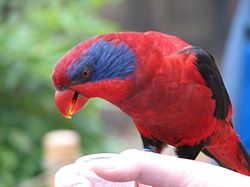| Eos | |
|---|---|
 | |
| Violet-necked lory (Eos squamata) | |
| Scientific classification | |
| Kingdom: | Animalia |
| Phylum: | Chordata |
| Class: | Aves |
| Order: | Psittaciformes |
| Family: | Psittaculidae |
| Tribe: | Loriini |
| Genus: | Eos Wagler, 1832 |
| Type species | |
| Psittacus indicus [1] = Psittacus histrio Gmelin, 1788 | |
| Species | |
6, see text. | |
Eos is a genus of parrots belonging to the lories and lorikeets tribe of the family Psittaculidae. There are six species which are all endemic to islands of eastern Indonesia, [2] [3] most within very restricted ranges. They have predominantly red plumage with blue, purple or black markings. Males and females are similar in appearance.
Contents
- Description
- Behaviour and ecology
- Status and conservation
- Taxonomy
- Species details
- References
- Cited texts
- External links
Their habitats include forest, coconut plantations and mangroves. They gather in flowering trees to feed on nectar and pollen with their brush-tipped tongues. Fruit and insects are also eaten. They make nests in tree hollows generally high in old large trees. Threats to these parrots include habitat loss and trapping for the cagebird trade, and one species, the red-and-blue lory, is classified as endangered.






